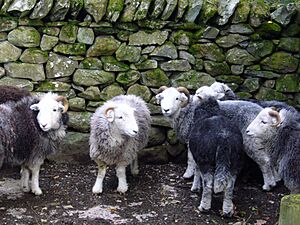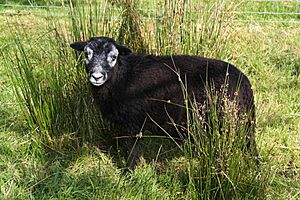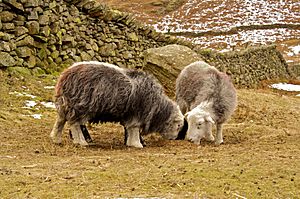Herdwick facts for kids
The Herdwick is a special type of domestic sheep that comes from the Lake District in North West England. Its name, "Herdwick," comes from an old language called Old Norse. It means "sheep pasture."
Even though Herdwick sheep don't have as many lambs or as soft wool as some other sheep, they are loved for being very strong and healthy. They can live just by eating plants found in nature. They also tend to stay in their own area and don't wander off, which is helpful in the tricky, hilly land of the Lake District. Almost all Herdwick sheep (about 99%) live and are farmed in the central and western parts of the Lake District.
Herdwick wool is very strong and unique. It has thick, bristly fibers that stick out from clothes made from it. This creates a protective layer, much like how it protects the sheep in snowstorms. Herdwicks have even been known to survive under deep snow for three days by eating their own wool!
In 2001, a serious animal sickness called foot-and-mouth disease spread across England and Wales. This put the Herdwick breed in great danger. However, people worked hard to save these unique animals because they are a key part of farming traditions in the Lake District. There are still fewer Herdwicks than many other farm sheep, but they survive mostly thanks to farming support payments.
Contents
History of Herdwick Sheep
Ancient Origins
The word "herdvyck," meaning "sheep pasture," was used in old papers as far back as the 1100s. No one knows exactly where Herdwick sheep first came from. However, many people believe that their ancestors were brought to England by Norse settlers. This would have happened between the 900s and 1000s during the Viking invasions.
Some old stories say the sheep came from a wrecked Spanish Armada ship. But it seems clear that Herdwicks were already very important in the Lake District by the late 1100s.
For hundreds of years, raising Herdwick sheep has greatly shaped the culture and landscape of the Lake District. Because sheep graze there, the hillsides are mostly treeless. The many dry stone walls in the valleys were built to protect grazing areas and keep the sheep from wandering. Even many local words in the Lake District are about sheep farming. An old sheep-counting system called Yan Tan Tethera is still used. It comes from an even older counting system used by the ancient Britons.
Beatrix Potter's Love for Herdwicks
Later in her life, after she was 50, the famous children's author Beatrix Potter became very involved with Herdwicks. She raised and bred them, and even led the breed association for a while. Between 1930 and 1938, she won many awards for her Herdwick ewes at shows across Cumbria.
When she passed away in 1943, she left fifteen farms, about 4,000 acres (16 square kilometers), to the National Trust. She asked that all these farms continue to raise Herdwick sheep.
Modern Times and Challenges
Today, the main business in the Lake District has changed from farming to tourism. Sometimes, the many tourists visiting the area cause problems for traditional life, including raising Herdwicks. One farmer explained it like this: "We get 100,000 visitors across our land every year... If just one in a thousand forgets to shut a gate or can't be bothered, that's a hundred times we have to go out and round up our sheep."
By the late 1900s, it became hard to make money from Herdwicks without outside help. The price for Herdwick fleece (their wool) sometimes dropped to less than a penny per kilogram. This is about the weight of wool from one sheep. Without money guarantees from the National Trust, it actually cost farmers more to shear their sheep than they would earn from the wool. Many farmers used to burn the wool as waste.
Now, the National Trust buys the wool itself. This helps them get better prices directly from the British Wool Marketing Board and even has a special Herdwick wool trademark. Most farmers now make money by selling lambs and through farming support payments from the National Trust and the European Union. Farmers in the Lake District get extra payments because their land is considered a "Less Favoured Area." Those who agree to farm in ways that protect the environment also get more payments.
About 95% of all 50,000 Herdwick sheep live within 14 miles of Coniston, Cumbria. This makes them very open to diseases. The foot-and-mouth disease outbreak in 2001 caused many flocks to be destroyed. People worried that the breed and the traditional Lake District sheep farming would disappear. About 25% of the estimated 100,000 Herdwick sheep were lost.
It was hard to replace these sheep because long-standing herds are "hefted." This means they learn to stay in a specific small area of the hills. If new sheep were brought in, they would need a lot of fencing to keep them from wandering. Many people, including important landowners, wanted to save the hill sheep. They saw Herdwicks as a key symbol of the region.
When entire flocks were destroyed, shepherds had to "heaf" (the local word for heft) their new sheep to the hills again. Normally, mother sheep teach this behavior to their lambs. But with no old ewes left who knew their heaf, the new sheep had to be taught from scratch. This meant a lot of work rounding up sheep that had wandered across the hard-to-reach hills. Unhefted sheep might also eat too much grass in one spot if they replaced the original Herdwicks.
After the disease, the Cumbria Hill Sheep Initiative was started to help farmers. Strict government rules are still in place to prevent another outbreak.
In 2008, a sheep farmer in Oregon, USA, started bringing semen from Herdwick rams into the United States. This was to begin a breeding program using artificial insemination. It was the first time the breed was brought to the country. In 2013, Lakeland Herdwick meat received a special label from the European Union. This label means it is a "Protected Designation of Origin," showing it comes from a specific place and has special qualities.
Herdwick Characteristics
Herdwicks are a "dual-purpose" breed. This means they are good for two things: producing tasty lamb and mutton (sheep meat) and coarse, grey wool. This slowly growing breed is one of the toughest British hill sheep. They can handle the cold and constant rain of the Lake District, even at heights over 3,000 feet (about 1,000 meters).
Most Herdwicks spend winter on the fells (hills), from about December to April. They usually graze freely on the hillsides without extra food. But each ewe (female sheep) tends to stay in her "heaf" (her own small area of the fell). Because of the tough conditions on the fells, up to 25% of lambs can be lost. This ability to survive on their own is why fell farmers value Herdwicks so much, even more than sheep that produce more in easier areas.
A Herdwick's grey wool is not easy to dye and is coarse. So, it's best for making carpets. The wool is also a great natural insulator. You can even buy fireproofed sheets of Herdwick wool to use as insulation in lofts. Herdwick lamb and mutton have a very special taste. It was even served at Queen Elizabeth II's coronation party in 1953! Herdwick ewes also often produce good lambs for sale by breeding with other types of sheep like Suffolk, Cheviot, Charollais, and Texel sheep.
Herdwick lambs are born black. After about a year, they turn a dark brown color. At this stage, they are called hoggs or hoggets. After their first shearing, their wool becomes even lighter, turning grey. Male Herdwicks (rams) have horns, but female Herdwicks (ewes) do not.
For shows and auctions, Herdwicks traditionally have their wool "ruddied up" (colored with dye). Rams are also ruddied when they are put with the ewes. This shows which ones have mated. The dye is also a way (called a smit) to mark sheep to show who owns them. Before chemical dyes, this dye was made from iron ore or graphite mixed with grease. For many years, the legal way to identify a shepherd's sheep was by cutting notches in a sheep's ear, called lug marks. Now, ear tags are used instead.





